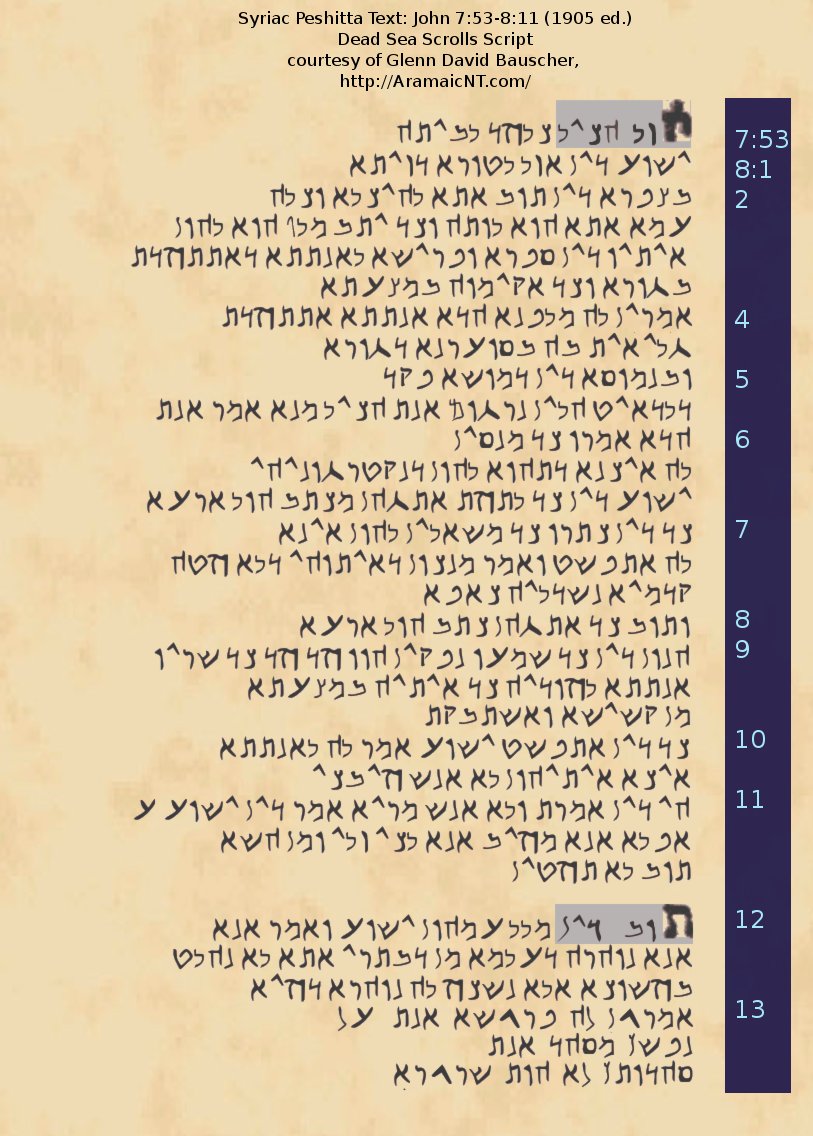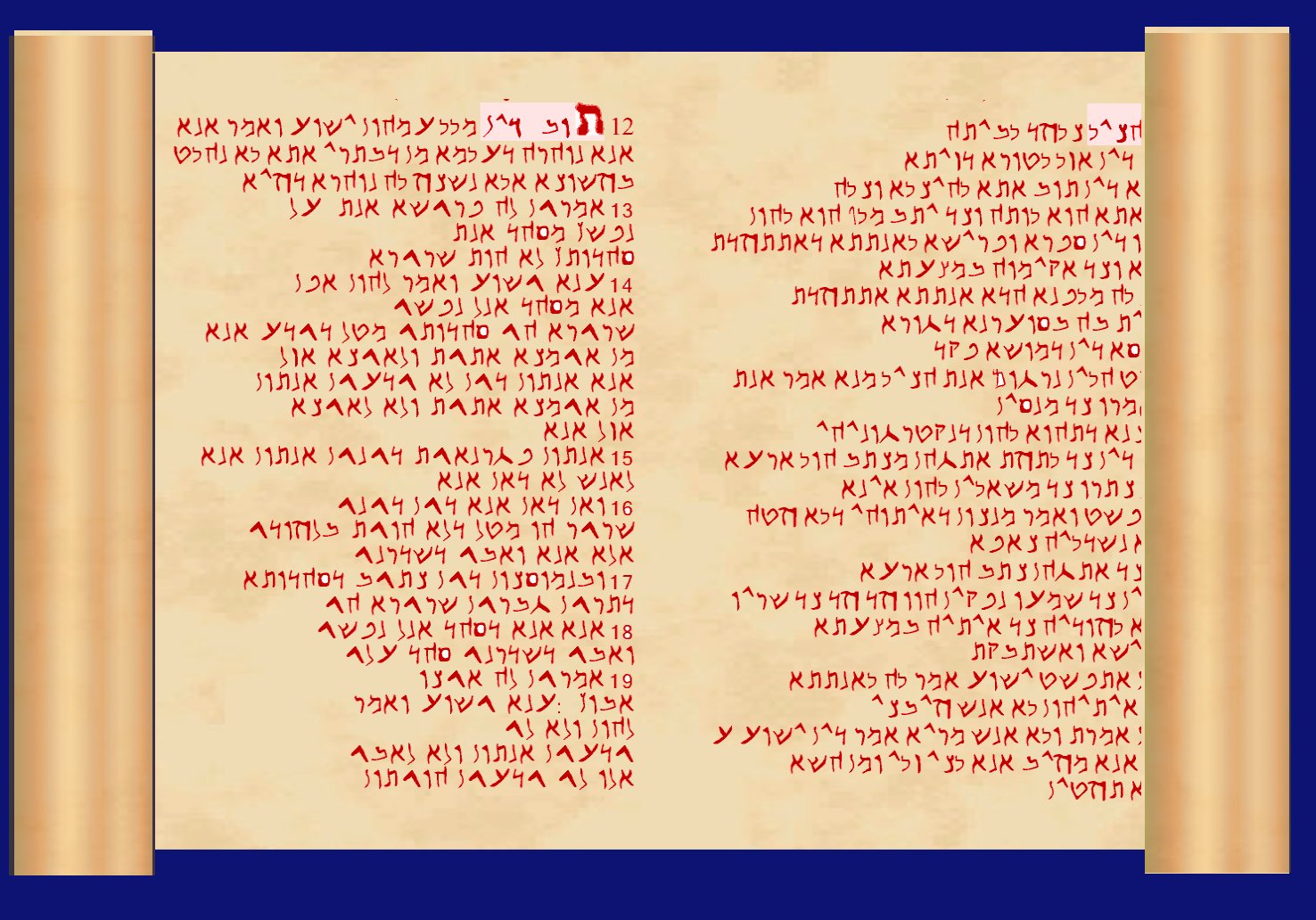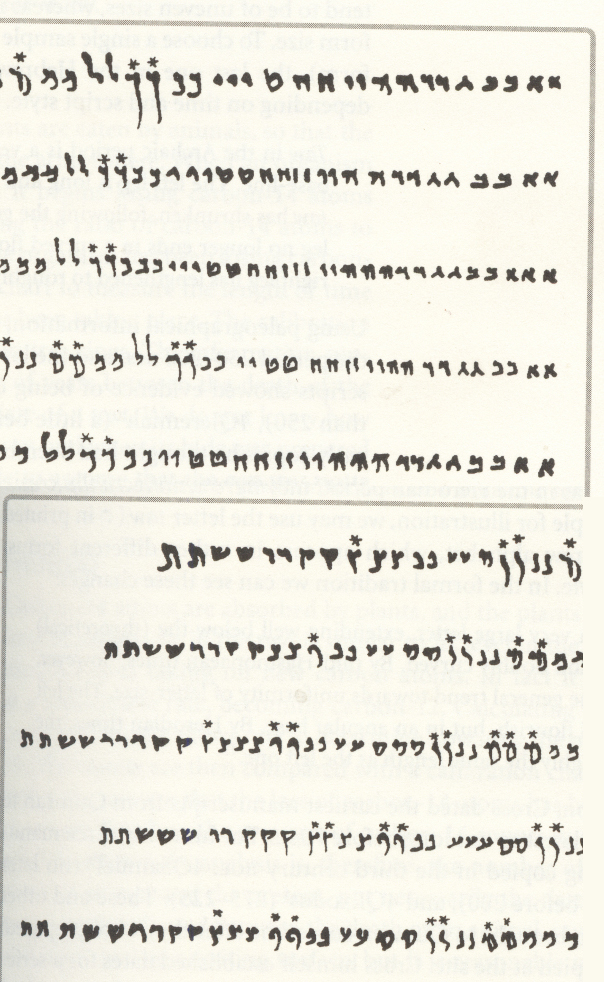Aramaic PA
A Case of Haplography?
Background
The Aramaic PA (Pericope de Adultera: John 7:53-8:11), reproduced and modified slightly here from the original work of Pastor Glenn David Bauscher: He has made the observation that if the PA is written in Aramaic (Syriac), in an Aramaic script contemporary with and localized to Palestine in the time of Jesus, that the beginning of the section and the one following are similar enough to create a potential Haplography situation.
The first six or seven letters of both verse 7:53 and 8:12 have been highlighted below, to show how similar they look in the common Aramaic Script used in Palestine and Judaea in the time of Jesus. The first letter of each verse has been enlarged, to show how the Dead Sea Scrolls script, when typically written, can allow for the easy confusion between the letter TAU and the letter ALEPH.
Aramaic PA
Using Dead Sea Scrolls Script

A cluster of six or seven similar letters at the beginning of the PA and the following section (8:12) are highlighted.
Page Sizes
on a Scroll
Haplographic errors (the skipping of text chunks) are rarely so large, normally. Typically a 'line ending' type error is but one line long.
In Greek this might be anywhere from 15-30 letters, often a short clause or phrase in length. Accidental omissions due to similar beginnings (Homoioarcton) are sometimes much longer, with typical skips of anywhere from two to five lines, although often only one or two.
What makes this case both plausible and interesting, is the fact that Aramaic copies of the very first Gospels may well have been scrolls, not codices (books with pages). On a Hebrew scroll, typically pages were written side by side along the scroll, so that it was unrolled sideways.
Bauscher has shown that the size of the PA is just about right for a single page when written in the DSS Aramaic script of Jesus' day. The PA is on left, below, with John 8:12 following at the top of next column:
Aramaic PA
Side by Side Pages on Scroll

Similar Column Beginnings
There is no doubt that placing columns side by side in a scroll compounds and enhances the chance of a 'page-size' Haplography error, especially of the Homoioarcton (similar beginnings) type. One can easily imagine the extra problems faced when copying scrolls as opposed to a codex. Scrolls have a tendency to 'roll up' when released.
If a scroll slipped, and then closed, a scribe could easily reopen it and begin at the wrong column when restarting, especially if the two had similar column-starts. No bumbling is needed per se. A scribe could close up his work for the shift/day, then reopen the scroll later at the approximate spot, but mis-identify the starting column when glancing back to his copy a second time.
Script Details:
The 'Herodian' Aramaic
A closer look at the various "Palestinian Aramaic" scripts used among the Dead Sea Scrolls and elsewhere confirm that many letters are unfortunately similar in shape and style, and even in how they would be stroked.
Bauscher has noted with wit that the 'Herodian' script affords the greatest similarity between the two proposed line starts (John 7:53 and 8:12). Herod's adultery was a public issue that caused the death of John the Baptist. He hints at another reason Palestinian Christians might have deleted the passage.
However, even without the Herodian script, the similarities between the lines remain strong. One finds that Aleph, H, K, M, all have unfortunate similarities that could cause misreading and confusion. This is true in almost any Dead Sea or Palestinian script.
Thus Bauscher's example reconstruction using the Herodian script in particular is not absolutely essential for an easy Haplography error in any case. A similar error could still occur in both older and newer scripts, or handwriting less sloppy.
Dead Sea Scroll Scripts

Line 1: A script between the Archaic (proto-Jewish) and Hasmonaean periods (ca. 175-150 BCE). From a Ms of Deut. (4QDeut -a).
Line 2: A typical Hasmonaean script (ca 125-100 BCE). From a Ms. of Deut. (4QDeut -c).
Line 3: A Late Hasmonaean script (ca. 50-25 BCE), Samuel (4QSam -a).
Line 4: A typical Early Herodian formal script (ca. 30-1 BCE) MS of the War Scroll (1QM[1Q33])
Line 5: An early Herodian "Round" semiformal hand (ca. 30 BCE - 20 CE) from a MS of Num. (4QNum -b).
Script samples exerpted for review from Vanderkim & Flint, Meaning of the DSS (2002, Harper)
Jack Kilmon was the scholar who provided many of the ancient language fonts for internet and scholarly use, free of charge. His Dead Sea Scroll font was used to layout the passage. He comments on the possibility of Syriac Haplography at TC-Alt List: Response:
Jack Kilmon on
Syriac HomoioArcton'Syriac is a late Eastern dialect of Aramaic. The Old Syriac and Peshitta texts were translated from Greek texts between the 2nd and 5th centuries in Syria and are not the progenitors of the Greek texts. The Aramaic that does lie inj translation beneath certain NT passages would be first century Judean Aramaic and NOT Syriac. Regardless, azel hakyl (beginning of 7:53) and tob dyn Beginning of 8:12) do have some similarity in the Hasmonean and Herodian scripts but the author of this paper modifies the alef in azl to more closely resemble the taw of tob and he uses a modern Ashuri lamed in place of the Herodian lamed to resemble the beyt of tob. I am gratified that he uses the ancient scripts I designed just for this purpose of scholarly portrayals. For anyone on this forum that may have a need for ancient Semitic, Greek and Latin fonts, help yourself in the "downloads" section of my website at http://www.historian.net
In short, I do not think the resemblance is close enough to be convincing for an haplographic scribal error, at least in 4G. I am not saying it is not possible given differences in scribal hands but there may be reason to suggest that the PA circulated in Old Syriac. The Gospel of John does indeed have the strongest Aramaic syntactic and lexical interference but this is due, IMO, to Aramaic source documents that the author (John of Ephesus) used to compose his Greek gospel. The PA, like the prologue (also not part of the autograph 4G) is not translational Greek. It does contain an Aramaism (arxomai apo) that I find interesting because it appears to be a "Lukanism" (Lk 23:5, 24:27, 47; Acts 8:35) and the text appears following Luke 21:38 in four mss and in the Family 13 mss after Luke 24:53. That reference to the PA occurs first in the 3rd century Didascalia Apostolorum (A Syrian document) may also suggest a Syrian origin which would be in agreement with Chase and Torrey (Luke was probably from Antioch) and its first scriptural appearance in C. Bezae.
The Old Syriac mss, both S and C do not have the PA yet the Peshitta does but the Peshitta composers used the OS PLUS the Greek texts to produce what they thought would be a superior Syriac text. The PA may well have had its origins in the Syriac, perhaps circulating orally before being included in the Didascalia and afterwards incorporated in scripture, perhaps a Western/Caesarean exemplar for Bezae.
The Peshitta is dependant on the Old Syriac which did not have the PA. The Peshitta (late 3rd-4th century) had the PA and the Philoxian (507-508 CE), dependant on the Peshitta, had the PA. The Harklean (616 CE), dependant on the Byzantine as a revision of the Philoxian, did not have the PA. This suggests that the Byzantine archetypes did not have the PA and all of the Alexandrian texts omit it. That it was in D and later secondary Byzantines does not support its omission as a result of a haplographic error translating from Syriac to Greek. I think it was included as a "floating text" in some Western texts and the Greek archetype of the Peshitta from the Didascalia or made its way to the Didascalia from the Greek archetype.
Interesting stuff though.
Jack
- Jack Kilmon, msg #2807 Oct 8, 2009, TC-Alt List